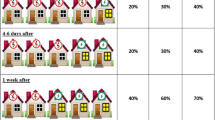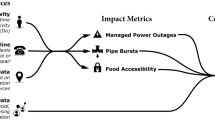Abstract
Large-scale damage to the power infrastructure from hurricanes and high-wind events can have devastating ripple effects on infrastructure, the broader economy, households, communities, and regions. Using Hurricane Irma’s impact on Florida as a case study, we examined: (1) differences in electric power outages and restoration rates between urban and rural counties; (2) the duration of electric power outages in counties exposed to tropical storm force winds versus hurricane Category 1 force winds; and (3) the relationship between the duration of power outage and socioeconomic vulnerability. We used power outage data for the period September 9, 2017–September 29, 2017. At the peak of the power outages following Hurricane Irma, over 36% of all accounts in Florida were without electricity. We found that the rural counties, predominantly served by rural electric cooperatives and municipally owned utilities, experienced longer power outages and much slower and uneven restoration times. Results of three spatial lag models show that large percentages of customers served by rural electric cooperatives and municipally owned utilities were a strong predictor of the duration of extended power outages. There was also a strong positive association across all three models between power outage duration and urban/rural county designation. Finally, there is positive spatial dependence between power outages and several social vulnerability indicators. Three socioeconomic variables found to be statistically significant highlight three different aspects of vulnerability to power outages: minority groups, population with sensory, physical and mental disability, and economic vulnerability expressed as unemployment rate. The findings from our study have broader planning and policy relevance beyond our case study area, and highlight the need for additional research to deepen our understanding of how power restoration after hurricanes contributes to and is impacted by the socioeconomic vulnerabilities of communities.



Source: Hurricane Irma power outage data, Florida Division of Emergency Management



Similar content being viewed by others
Notes
The six-level urban–rural classification scheme:
-
1.
Large central metro counties in MSA of 1 million population that: (1) contain the entire population of the largest principal city of the MSA, or (2) are completely contained within the largest principal city of the MSA, or (3) contain at least 250,000 residents of any principal city in the MSA.
-
2.
Large fringe metro counties in MSA of 1 million or more population that do not qualify as large central.
-
3.
Medium metro counties in MSA of 250,000–999,999 population.
-
4.
Small metro counties are counties in MSAs of less than 250,000 population.
-
5.
Nonmetropolitan counties: Micropolitan counties in micropolitan statistical area.
-
6.
Noncore counties not in micropolitan statistical areas.
-
1.
The 2012-2016 ACS 5-year estimates are based on data collected from January 1, 2012 to December 31, 2016, released by the US Census Bureau on December 7, 2017 (https://www.census.gov/programs-surveys/acs/news/data-releases/2016/release.html).
References
Anselin L (1988) Spatial econometrics: Methods and models. Kluwer, Dordrecht
Anselin L (2002) Under the hood: issues in the specification and interpretation of spatial regression models. Agric Econ 27(3):247–267
Anselin L, Lozano-Garcia N (2008) Errors in variables and spatial effects in hedonic house price models of ambient air quality. Empirical Economics 34(1):5–34
Anselin L, Bera A, Florax R, Yoon M (1996) Simple diagnostic tests for spatial dependence. Reg Sci Urban Econ 26:77–104
Auerswald P, Branscomb LM, La Porte TM, Michel-Kerjan E (2005) The challenge of protecting critical infrastructure. Issues Sci Technol 22(1):77–80
Austin RF, DiSera DP, Brooks TJ (2015) GIS for critical infrastructure protection. CRC Press, Boca Raton
Beatty ME, Phelps S, Rohner C, Weisfuse I (2006) Blackout of 2003: public health effects and emergency response. Public Health Rep 121:36–44
Burger B, Gochfeld M, Pittfield T, Jeitner C (2017) Responses of a vulnerable Hispanic population in New Jersey to Hurricane Sandy: access to care, medical needs, concerns, and ecological ratings. J Toxicol Environ Health Part A 80(6):315–325
Cangialosi JP, Latto AS, Berg R (2018) National hurricane center tropical cyclone report: Hurricane Irma 30 August–12 September 2017. National Oceanic and Atmospheric Administration and National Hurricane Center. Retrieved March 2018 from https://www.nhc.noaa.gov/data/tcr/AL112017_Irma.pdf
Cutter SL, Boruff B, Shirley W (2003) Social vulnerability to environmental hazards. Soc Sci Q 84(2):242–261
Cutter SL, Burton CG, Emrich CT (2010) Disaster resilience indicators for benchmarking baseline conditions. J Homel Secur Emerg Manag 7(1):1547–7355
Cutter SL, Ash KD, Emrich CT (2016) Urban–rural differences in disaster resilience. Ann Am As Geogr 106(6):1236–1252
Dong X, Shinozuka M, Chang S (2004) Utility power network systems. In: 13th world conference on earthquake engineering Vancouver, B.C., Canada August 1–6, 2004 Paper No. 527. http://www.iitk.ac.in/nicee/wcee/article/13_527.pdf. Accessed 27 March 2018
Esnard A-M, Sapat A, Mitsova D (2011) An index of relative displacement risk to hurricanes. Nat Hazards 59(2):833–859
FEMA (Federal Emergency Management Agency) (2017) Power outage incident annex to the response and recovery federal interagency operational plans: managing the cascading impacts from a long-term power outage. Retrieved March 2018 from https://www.fema.gov/media-library/assets/documents/154058
Florida Public Service Commission (2017) Facts and figures of the Florida utility industry. Office of Consumer Assistance and Outreach, Florida Public Service Commission, Tallahassee, FL. Retrieved March 2018 from http://www.psc.state.fl.us/Files/PDF/Publications/Reports/General/Factsandfigures/March%202017.pdf
Guikema SD, Quiring SM, Han SR (2010) Prestorm estimation of hurricane damage to electric power distribution systems. Risk Anal 12:1744–1752
Han SR, Guikema SD, Quiring SM, Lee KH, Rosowsky D, Davidson RA, Han SR (2009) Estimating the spatial distribution of power outages during hurricanes in the Gulf coast region. Reliab Eng Syst Saf 94(2):199–210
Hasan S, Foliente G (2015) Modeling infrastructure system interdependencies and socioeconomic impacts of failure in extreme events: emerging R&D challenges. Nat Hazards 78:2143–2168
He M, Lin K-P (2015) Testing in a random effects panel data model with spatially correlated error components and spatially lagged dependent variables. Econometrics 3:761–796
Huang C, Liou JJH, Chuang Y (2014) A method for exploring the interdependencies and importance of critical infrastructures. Knowl-Based Syst 55:66–74
IFRC (International Federation of Red Cross and Red Crescent Societies) (2016) What is vulnerability? Retrieved August 2016 from https://www.ifrc.org/en/what-we-do/disaster-management/about-disasters/what-is-a-disaster/what-is-vulnerability/
Kelejian HH, Prucha IR (2007) HAC estimation in a spatial framework. J Econom 140:131–154
Klas M-E (2017). Is South Florida more prepared than it was 12 years ago with Wilma? Miami Herald (September 6). Retrieved March 2018 from http://www.miamiherald.com/news/state/florida/article171543712.html
Klinger C, Landeg O, Murray V (2014) Power outages, extreme events and health: a systematic review of the literature from 2011 to 2012. PLOS Curr Disasters 2014 Jan 2. Edition 1. https://doi.org/10.1371/currents.dis.04eb1dc5e73dd1377e05a10e9edde673
Kraushar ML, Rosenberg RE (2015) A community-led medical response effort in the wake of Hurricane Sandy. Disaster Med Public Health Prep 9(4):354–358
Lai BS, Lewis R, Livings M, La Greca AM, Esnard A-M (2017) Posttraumatic stress symptom trajectories among children after disaster exposure: a review. J Trauma Stress 30:571–582
Larsen T, Porter K, Zadeh M, Van Anne C, Scawthorn C (1996) Impact of Hurricane Andrew on performance, interaction, and recovery of lifelines. EQE Int. Retrieved July 2018 from http://www.sparisk.com/pubs/Larson-1996-Andrew-Lifelines.pdf
Laska S, Morrow B (2006) Social vulnerabilities and Hurricane Katrina: an unnatural disaster in New Orleans. Mar Technol Soc J 40(4):16–26
Liévanos RS, Horne C (2017) Unequal resilience: the duration of electricity outages. Energy Policy 108:201–211
McRoberts DB, Quiring SM, Guikema SD (2016) Improving hurricane power outage prediction models through the inclusion of local environmental factors. Risk Anal. https://doi.org/10.1111/risa.12728
Miller K (2016) Record-shattering Hurricane Wilma hit Florida 11 years ago today. Palm Beach Post. 24 October 2016. Retrieved March 2018 from http://weatherplus.blog.palmbeachpost.com/2016/10/23/record-shattering-hurricane-wilma-hit-florida-11-years-ago-monday/
Miller TR, Chester M, Munoz-Erickson TA (2018) Rethinking infrastructure in an era of unprecedented weather events. Issues Sci Technol Nat Acad Sci Eng Med Winter 2018:46–58
Mitsova D, Sapat A, Esnard A-M, Lamadrid A (2018) An exploratory framework to examine the interdependent effects of critical infrastructure breakdowns on the emergency services sector (ESS) in extreme events. Working paper, Florida Atlantic University
Murià-Vila D, Jaimes MÁ, Pozos-Estrada A, López A, Reinoso E, Chávez MM, Fernando Peña F, Sánchez-Sesma J, López O (2018) Effects of hurricane Odile on the infrastructure of Baja California Sur, Mexico. Nat Hazards 91(3):963–981
Nateghi R, Guikema SD, Quiring SM (2011) Comparison and validation of statistical methods for predicting power outage durations in the event of hurricanes. Risk Anal 31:1897–1906. https://doi.org/10.1111/j.1539-6924.2011.01618.x
Peacock WG, Girard C (1997) Ethnicity and segregation. In: Peacock WG, Morrow BH, Gladwin H (eds) Hurricane Andrew: Ethnicity, gender, and the sociology of disaster. Routledge, New York, pp 191–205
Peacock WG, Van Zandt S, Henry D, Grover H, Highfield W (2012) Social vulnerability and Hurricane Ike: Using social vulnerability mapping to enhance coastal community resilience in Texas. In: Bedient PB (ed) After Ike: severe storm prediction, impact, and recovery on the Texas Gulf coast. Texas A&M University Press, Collge Station, pp 66–81
Peeters L, Chasco C (2006) Ecological inference and spatial heterogeneity: an entropy-based distributionally weighted regression approach. Pap Reg Sci 85(2):257–276
Tonn GL, Guikema SD, Ferreira CM, Quiring SM (2016) Hurricane Isaac: a longitudinal analysis of storm characteristics and power outage risk. Risk Anal 36:1936–1947. https://doi.org/10.1111/risa.12552
Zimmerman R (2016) Resilient urban infrastructure for adapting to environmental disruptions. In: Seto KC, Solecki WD, Griffith CA (eds) Handbook on urbanization and global environmental change. Routledge, London, pp 488–512
Zimmerman R, Farris C (2010) Infrastructure impacts and adaptation challenges. Ann N Y Acad Sci 1196:63–85
Zimmerman R, Zhu Q, de Leon F, Guo Z (2017) Conceptual modeling framework to integrate resilient and interdependent infrastructure in extreme weather. J Infrastruct Syst 23(4):04017034
Acknowledgements
This article is based on research supported by two US National Science Foundation Grants (CMMI#1541089 and CMMI#1634234). This manuscript would not have been possible with the archived power outage data from the Florida Division of Emergency Management. Any opinions, findings, conclusions, or recommendations expressed here are those of the authors and do not necessarily reflect the views of the National Science Foundation. We also wish to acknowledge Natasha Malmin for her assistance with collecting, formatting the power outage data and the Census data, with creating maps and with preliminary statistical analysis.
Author information
Authors and Affiliations
Corresponding author
Rights and permissions
About this article
Cite this article
Mitsova, D., Esnard, AM., Sapat, A. et al. Socioeconomic vulnerability and electric power restoration timelines in Florida: the case of Hurricane Irma. Nat Hazards 94, 689–709 (2018). https://doi.org/10.1007/s11069-018-3413-x
Received:
Accepted:
Published:
Issue Date:
DOI: https://doi.org/10.1007/s11069-018-3413-x




